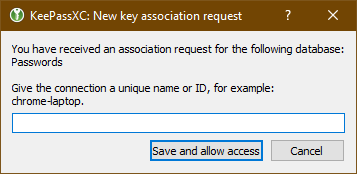

- Firefox keepassxc how to#
- Firefox keepassxc full#
- Firefox keepassxc software#
- Firefox keepassxc password#
Firefox keepassxc password#
Using a password manager creates a single point of failure and establishes an obvious target for bad actors or adversaries. This guide recommends KeePassXC because it is cross-platform and more actively developed than some of the alternatives. Some of these are based on the same code, while others just use the same database format. There are a number of programs with names similar to KeePassXC, like KeePassX, KeePass, and KeePass2. You only need to remember one master password that allows you to access the encrypted password manager database of all your passwords. A password manager is a tool that creates and stores passwords for you, so you can use many different passwords on different sites and services without having to memorize them. Goodbye LastPass and thanks for all the fish.KeePassXC is a cross-platform password manager that allows you to store all of your passwords in one location. My thanks to the KeePassXC developers for providing us with the best cross-platform free and open-source password manager.
Firefox keepassxc how to#
Please refer to How to connect KeePassXC-Browser with KeePassXC for a quick tutorial on configuring browser integration.
Firefox keepassxc full#
The animated gif below shows the browser extension in its full glory. I’ve been experimenting with the Firefox extension and found it to be working as advertised, without any complications. KeePassXC also provides official browser extensions for Firefox, Google Chrome, Chromium and Vivaldi. KeePassXC 2.3.4 running on Arch Linux x86_64. The next image shows the entry for the converted “database note type” from LastPass (secure notes) after running the import. Importing CSV fields from the LastPass export file The following image shows KeePassXC’s import CSV fields screen with the column mapping applied as earlier specified: KeePassXC Created: LastPass Not present in CSV file KeePassXC Last modified: LastPass Not present in CSV file The mapping itself is rather straightforward. Next, we’ll enter the CSV import screen to map the columns from the export file against KeePassXC’s corresponding columns. Choose a password and optionally add a key file before hitting the “OK” button. The columns from the export are arranged in the following order, which will have significance when the CSV file is to be imported with KeePassXC: url: column1įav: column7 Importing a CSV file with KeePassXCįire up KeePassXC and select Database => Import => Import CSV file. The content of the file is available in clear text so we can observe both user credentials and the database configuration for this site: configuration for ", - DB,Secure Notes,0 The following file consists of two regular sites and a secure note. Let’s examine the exported file from LastPass. Using the LastPass extension, simply navigate to: More options => Advanced => Export => LastPass CSV file and save the resulting file using the. Thankfully, LastPass has made it easy to export and migrate your data by allowing it to be exported as a CSV file.

As faith would have it, a fork of KeePassX, the password manager I was previously using before moving everything off to LastPass. Enter KeePassXC, a free and open-source password manager. KeePassXC 2.3.4 running on Arch Linux x86_64.Īnyhow, it’s finally time to smell the hobbit and retake control of my precious. Sadly, the answer is that I’m just that lazy and LastPass made things very convenient.
Firefox keepassxc software#
I’ve been pondering the reasons as to why I’m now depending on this piece of proprietary software that’s happily storing all my sensitive credentials on somebody else’s server. I’ve never really felt all that good about storing my passwords on the public cloud, but after we started using LastPass at work I somehow got lulled into adopting it for personal use as well.


 0 kommentar(er)
0 kommentar(er)
